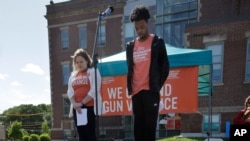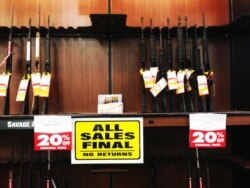Activists in the United States are hoping to see buildings across the country bathed in orange on Friday to commemorate National Gun Awareness Day to honor victims and survivors of gun violence.
The Wear Orange campaign seeks to raise awareness about gun violence and encourages people to dress in orange clothing on Friday and for organizations and businesses to light their buildings in orange — the color hunters wear to protect themselves and others from an accidental shooting.
Organizers say that in 2020, #WearOrange trended nationally on Twitter with more than 150,000 Americans taking part, along with more than 300 businesses. They say more than 100 buildings and landmarks, including 11 stadiums, turned skylines orange last year.
Because of the coronavirus pandemic, events this year and last year are taking place virtually. Organizers are looking toward social media and encouraging supporters to post pictures of anything orange. Support last year came from musicians, actors, athletes and politicians, including then-presidential candidate Joe Biden and former President Barack Obama.
The Wear Orange campaign and National Gun Awareness Day began in 2015 to commemorate the death of Hadiya Pendleton, a high school student from the South Side of Chicago.
Pendleton marched in Obama’s second inaugural parade in 2013 and the following week was shot and killed on a playground in Chicago. Shortly after her death, Pendleton’s friends decided to commemorate her life by wearing orange. The campaign was born on June 2, 2015, what would have been Pendleton’s 18th birthday, and now takes place on the first Friday in June.
A study in May by the Pew Research Center found that guns are deeply ingrained in American society and the national political debate.
The research found that about a third of U.S. adults own a gun, and 44% say they live in a household with a gun. The rates of gun ownership vary based on political affiliation, sex and geography. Gun ownership rates are higher among Republicans than Democrats (50% vs. 18%); men than women (45% vs. 18%); and those living in towns or rural areas (48%) versus those living in suburbs (25%) or cities (23%).
Pew found that about half of Americans (48%) saw gun violence as a very big problem, with the rest saying it is either a moderately big problem (24%), a small problem (22%), or not a problem at all (6%). The attitudes differed significantly according to race, with 82% of Black respondents saying it is a very big problem, compared to 58% for Hispanic respondents and 39% for white respondents.
Americans are divided over gun control laws, with 53% favoring stricter gun control, according to the research. There is agreement between Republicans and Democrats for some gun policy proposals, including restricting gun access from the mentally ill (85% of Republicans and 90% of Democrats support this). However, other proposals are politically divisive, such as creating a federal database to track all gun sales, supported by 86% of Democrats but only 43% of Republicans.
Gun violence in the United States accounted for 39,707 deaths in 2019, the latest year for which data is available. According to figures from the U.S. Centers and Disease Prevention, the gun deaths included 23,941 suicides and 14,414 homicides.
Mass shootings are statistically rare, accounting for fewer than 1% of all firearm homicides in the United States. However, such shootings are becoming more deadly, and they create fear in the minds of the public, especially when the shootings take place in everyday locations such as schools, stores and workplaces.
In the decade beginning in 2000, an average of nine mass shootings occurred each year in the United States. During 2020, when much of the country was under coronavirus lockdowns, the number of mass shootings sharply declined, with only two recorded during the year.
The Congressional Research Service defines mass shootings as one event in which four or more people are killed with firearms, not including the gunman, and at least some of the shooting deaths occurred in a public place and in close proximity to each other. And finally, the killings are not attributable to an underlying criminal activity, like a robbery, or commonplace circumstance, like a romantic triangle.
Now that coronavirus restrictions are lifting across the country, mass shootings are again on the rise, with at least five taking place so far in 2021.















